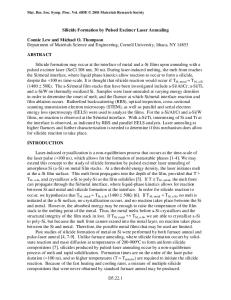Reflectivity of Silicon-On-Sapphire during Pulsed Laser Annealing
- PDF / 252,405 Bytes
- 5 Pages / 420.48 x 639 pts Page_size
- 88 Downloads / 383 Views
REFLECTIVITY OF SILICON-ON-SAPPHIRE DURING PULSED LASER ANNEALING
Y. H. CHEN* AND S. A. LYON** *Intel Corporation, Santa Clara, CA 95051 **Department of Electrical Engineering and Computer Science, Princeton University, Princeton, NJ 08544
ABSTRACT Using a visible probe laser (632.8 nm) we have directly observed motion of the melt front in silicon-on-sapphire during pulsed laser annealing. The average penetration and regrowth velocities have been determined to be 13 and 6.5 m/sec. respectively. These values are in agreement with recent conductivity measurements and heat flow calculations. In addition, the data demonstrate that the high-reflectivity phase can penetrate at least .5 um (Si thickness) and requires a significant amount of the time to do so. These results are further evidence that the high-reflectivity phase is molten silicon.
INTRODUCTION We have made the first direct optical measurements of the penetration velocity of the melt front during pulsed laser annealing of silicon-on-sapphire (SOS). The data agree well with recent conductivity measurements [1] and heat flow calculations [2]. Also the results provide strong evidence for the "melting model" [3] and are inconsistent with the "Bose condensed phase model" [4] of pulsed laser annealing. Using SOS, it is possible to study the Si layer from both sides using a visible probe laser (632.8 nm). An SOS sample with a Si thickness of .053 um was used in the experiments. A frequency-doubled Nd:YAG laser (532 nm) incident on Si side of the SOS provided 15 ns annealing pulses. At 2 an annealing energy density of 1.7 S/cm , a high-reflectivity phase lasting about 120 ns was observed when probing from the Si side. This high-reflectivity period represents the total time that the Si surface was molten. When the reflectivity was measured from the sapphire side of the SOS, a small peak in reflectivity was observed approximately 40 ns after the annealing pulse. This reflectivity peak occurs when the melt front reaches the Si-sapphire interface and forms a planar mirror-like surface. Since the melt front penetrates the entire Si thickness (0.53 um) in 40 nanoseconds, we deduce an average melt-in velocity of 13 m/sec. The Si layer fully resolidifies after another 80 ns and thus we determine an average regrowth speed of 6.5 m/sec.
EXPERIMENTAL RESULTS The optical arrangement used for the reflectivity measurements with the SOS is sketched in Fig. 1. The laser produced 15 ns pulses with approximately a Gaussian-shaped spatial intensity distribution. A lens with long focal length was used to loosely focus the annealing beam to about a 2 mm diameter spot at the sample. When the silicon thickness was greater than 400 nm, the energy per pulse used in the experiments was 70 mJ. If the Si thickness was less than 400 nm, the annealing energy was decreased to avoid surface damage.
Mat. Has. Soc. Symp. Proc. Vol. 23 (1984) Q Elsevier science Publishing Co., Inc.
174
Si
1
sapphire
lacesZ
ript, e.Ie't'r•oZ , Fig. Fig. 1
1
eWideband amplier and Oscilloscope
Experimental
Data Loading...






